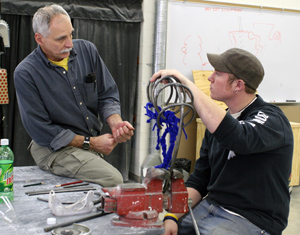When Wabash College students compare their ‘level of engagement’ against their peers they come out on top. When student engagement is compared to national averages, the College scores are often substantially higher. And when student engagement is measured against the very best scores in the country, Wabash students often set the benchmark.
 The 2006 National Survey of Student Engagement (NSSE) is based on information from about 260,000 randomly selected first-year and senior students at more than 520 four-year colleges and universities. The study gives schools an idea of how well students are learning and what they put into and get out of their undergraduate experience.
The 2006 National Survey of Student Engagement (NSSE) is based on information from about 260,000 randomly selected first-year and senior students at more than 520 four-year colleges and universities. The study gives schools an idea of how well students are learning and what they put into and get out of their undergraduate experience.
"This really demonstrates results as opposed to some of the other rankings which are often based on characteristics and statistics which haven't been proven to relate to learning," Dean of Admissions Steve Klein said. "The NSSE characteristics have been proven to relate to learning. It helps us promote not just Wabash learning but the Wabash advantage."
The survey questions students in five distinct categories: level of academic challenge, active and collaborative learning, student-faculty interaction, enriching education experience, and supportive campus environment. Each category is explained below along with the Wabash scores as they compare to peer colleges and the national averages.
In the five areas of effective educational practices, Wabash freshmen and seniors scored higher in every single category than peer and national averages with most rankings scoring above the 90th percentile.
The peers were 60 liberal arts colleges across the country. The list includes Allegheny, Bucknell, Denison, DePauw, Hanover, Hiram, Hope, Kenyon, Saint Olaf, Wooster, Washington, Wheaton and Wittenberg.
Level of Academic Challenge: Preparing for class (studying, reading, writing, rehearsing, etc., related to an academic program.)
|
First-year Students |
Seniors |
|
|
Wabash |
67.5 |
69.2 |
|
Peers |
57.4 |
61.1 |
|
National Average |
51.7 |
55.8 |
Active and Collaborative Learning: Asked questions in class, made class presentation, worked with other students, tutored, participated in a community-based project.
|
First-year |
Seniors |
|
|
Wabash |
52.9 |
58.1 |
|
Peers |
44.3 |
53.4 |
|
National Average |
41.3 |
50.4 |
Student-Faculty Interaction: Discussed grade or assignments with instructor, discussed career plans with faculty or advisor, discussed ideas from readings or classes with faculty outside of class, received prompt feedback from faculty on academic performance, worked with faculty on a research project outside of course or program requirements.
|
First-year |
Seniors |
|
|
Wabash |
50.8 |
65.4 |
|
Peers |
36.4 |
51.3 |
|
National Average |
32.1 |
41.3 |
Enriching Educational Experience: Co-curricular activities, internship or field experience, community service or volunteer work, foreign language or study abroad, independent study, serious conversations with students of different religious beliefs, political opinions or personal values, use technology to discuss or complete an assignment.
|
First-year |
Seniors |
|
|
Wabash |
41.0 |
63.4 |
|
Peers |
30.5 |
52.3 |
|
National Average |
26.7 |
39.9 |
Supportive Campus Environment: Environment provides support student needs to succeed, environment provides support to thrive socially, cope with non-academic responsibilities, quality of relationship with students, faculty and administrative personnel and offices.
|
First-year |
Seniors |
|
|
Wabash |
76.1 |
72.4 |
|
Peers |
63.9 |
61.7 |
|
National Average |
59.1 |
56.1 |